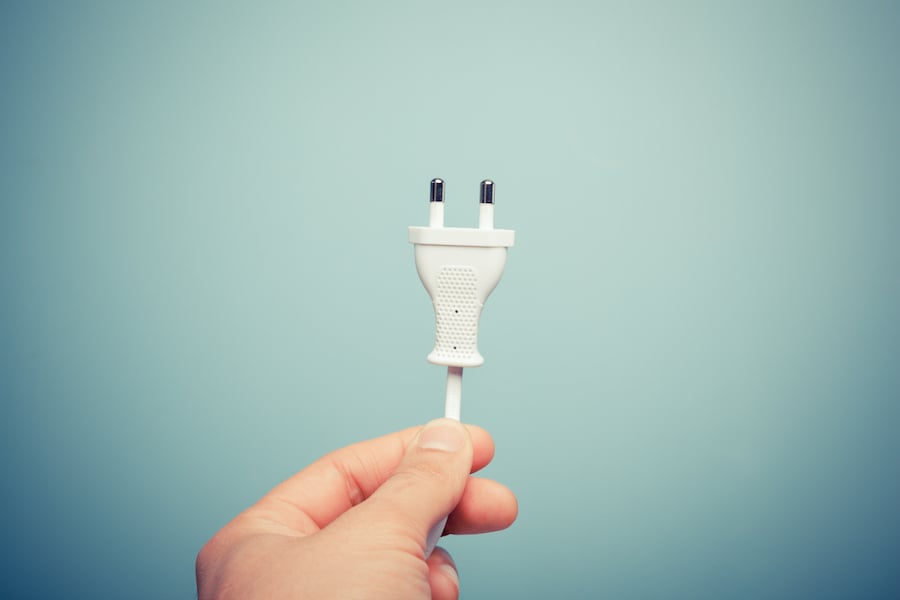
You know what? You work damn hard to get people to your blog.
Pushing yourself to unearth the best ideas, pouring your soul into your writing, and promoting your posts like your next breath depends on it.
So it’s a real kick in the teeth when visitors arrive — then bounce right away again.
In fact, it stings like hell. Because let’s face it, getting rejected always feels worse than just being ignored.
But that’s what a bounce means to a blogger — rejection. It means someone showed up, checked you out, and didn’t like what they found.
Whether you know how many readers are bouncing or not, the signs are obvious. Low traffic, poor engagement, sluggish list growth. These are all the symptoms of a bouncy blog.
Naturally, no blog will be a perfect match for everyone who might wander up to the front porch. But if most people who land on your blog can’t wait to leave again, you have a serious problem, friend.
And while you can’t make your blog bounce-proof, you can at least make it bounce resistant.
But only if you know why people bounce.
So here they are, the reasons people bounce from your blog and never return.
Your Headline’s Writing Checks Your Post Can’t Cash
If you’re reading this blog, you should already understand the importance of headlines.
Your headlines entice people over from wherever they are to where you want them to be — your blog. And a weak headline will kill your post, no matter how magnificent the content might be.
You must never forget that a headline is a solemn promise from you to your reader. It says: “Lend me your attention and I’ll give you this result.”
But if a “Yeah!” headline leads them to a “meh” post, that’s a surefire formula for bouncing.
So start with a strong topic idea, not just an enticing headline.
Write something worth reading and then, craft the headline that’ll bring people running.
You’ll know you’re onto something when you worry your headline won’t live up to the standard of your post.
You’re Over Eager (and It’s Embarrassing)
Imagine meeting someone in a bar, and the first words out of their mouth are: “Hey — can I get your number?”
You’d probably want to run a mile.
Well, that’s what it feels like to land on a blog for the first time and get hit with a pop-up demanding your email address.
It’s just too…soon. The reader hasn’t decided what they think about you yet, so they don’t want to hand over their details. After all, you might be a douche.
And it’s annoying too. Like those websites that ask you to complete a “survey about your experience” when you’ve been on the site all of two seconds.
So whoah there, cowboy. Let’s slow things down a bit. Let people settle in before you tap them on the shoulder and ask for personal details.
Because when you ask too much too soon, all you do is make people want to bounce.
You Make People Exhausted Not Energized
Many bloggers think of themselves as teachers. And that’s fine because many readers read blogs to learn.
But the purpose of your blog post is not just to transfer information from your brain to the reader’s. That’s part of it, but it’s far from the full picture.
Just think about your favorite teachers from school. They weren’t the ones who knew the most. Or even the ones whose classes got the best grades. They were the ones who made the subject fun. At the end of the class, you had more passion and enthusiasm for the subject than when you started.
And that’s how the best bloggers are too. They’re not just teachers, but performers.
Because if all you do is teach, your reader’s energy levels will fall — because learning takes mental effort.
That’s why you need to invigorate your readers too. Give them the energy they need to dive into your next post.
You’re Too Damn Wordy (Even for a Writer)
We writers love words. We’re fascinated by their myriad possibilities and we can toy with the same paragraph for an hour and still not get bored.
But for the average blog reader, words are simply a means to an end — getting the information they need.
So readers do not want to click your link and then see a seemingly unclimbable wall of plain text.
Texty is not sexy.
So if your posts are as visually appealing as iTunes’ mile-long Terms and Conditions page, your blog will be as bouncy as a kangaroo on a pogo stick.
Short sentences and paragraphs. Bulleted lists. Features and inline images. Quotes and callouts.
All of these can transform your post from hard-to-read to hard-to-resist.
And be sure you include some of this visual goodness “above the fold” (i.e., the part of the post that’s visible when you first land on the blog). Otherwise, people will never know what they’re missing if they bounce.
You Leave Your Readers Hanging
Sometimes people will like what they find on your blog, but they still bounce.
Often that just means they didn’t know what to do next. And in the absence of a better idea, clicked the “Back” button
That’s why smart bloggers always know what they want readers to do next — and they tell them.
So don’t leave a reader hanging. Instead, do one of the following:
- Direct them to a related post.
- Offer them a content upgrade.
- Ask them to complete a quick survey.
And keep the trail markers coming. Make sure you always have something for them to do next.
So, for instance, when someone signs up for your content upgrade (and your email list) put a link in the welcome email directing them back to the blog for something else to read.
When they do decide to leave your blog, just make sure it’s not because you didn’t invite them to stay longer.
Your Links are Too Damn Interesting
First things first. Putting external links in your posts is a good idea. Links boost credibility. They build goodwill with other bloggers. And they’re good for SEO.
But they can be dangerous too.
Every external link is a side tunnel that diverts readers away from their destination — finishing your post. Each one is an invitation to leave your blog forever.
So use external links sparingly and ensure they:
- Launch in a new window.
- Don’t break the flow of your writing (i.e., no attention-grabbing calls-to-action).
- Highlight supplemental, not essential information.
Readers might intend to return to your blog, but we all know the reality. Browsing the web is like diving from one rabbit hole to the next, and you rarely end up where you started.
You’re Thinking Too Big
I get it. Your content’s so good it deserves to be seen on a big screen.
You wouldn’t expect Interstellar to have the same impact on an iPhone as it does on an IMAX screen. Likewise, your blog deserves the full desktop experience.
But whether you like it or not, content’s going mobile. And readers don’t give a hoot how you’d like them to consume your work.
So if your content strategy is more mobile worst than mobile first, you might as well go the whole hog and start publishing your blog as a printed newsletter you mail out to your readers.
So get with the times Grandpa (or Grandma) and lean into mobile.
Your first task — test your blog to see if it’s mobile friendly. Better still, borrow every mobile device you can get your hands and find out what it’s actually like to spend time on your blog.
You might be (unpleasantly) surprised.
You’re Too Busy Trying to Make a Few Cents
“I didn’t like your blog because it didn’t have enough ads.”
Said nobody, ever.
We’re on record here as saying that most bloggers should steer well clear of ads, but if you’re hoping to keep people on your site, they’re a double threat.
For most readers, ads are an annoying distraction that cheapens your brand and increases the chances they’ll bounce. For the small percentage who are enticed by an offer, ads are an exit ramp taking them away from your content.
It’s a lose-lose situation for you as a blogger.
So ditch the ads. And stop giving people extra reasons to bounce from your blog.
You’re Convinced Your Content is Worth Waiting For
You know this already:
Readers bounce from slow sites.
You know it because you’re a reader and you bounce from slow sites too.
Life in the information fast lane moves too quickly to hang around waiting. Particularly when the “Back” button is right there. (I mean, it’s literally right there.)
You know this, but have you acted upon it?
For instance, do you know how fast your blog loads compared to other sites? Have you tested it?
Because it might load just fine for you, but that doesn’t make it so for other people. After all, you already have those big images cached on your browser, but what about the person arriving for the first time? You may be in the same country as your host’s server, but what about the guy reading your blog in India or Australia?
So test your website’s speed. And if it sucks, get it fixed.
You’re Exploring Well-Charted Territory
Humans are hopelessly addicted to novelty. Hence the modern addiction we have to our newsfeed.
Every time we click a link we hope to learn or see something new. Mostly we’re disappointed, but that hope remains.
That’s why the moment your blog content seems to say something we’ve heard before, expressed in the same way, we lose interest. And we bounce away in search of something else.
The antidote? Make sure you know what’s already been said on your chosen topic and navigate around those ideas. Or at least put a fresh spin on them.
Be bold. Brave. Even shocking.
But don’t ever be predictable.
You’re Scared of Commitment
Want to know one of the most common mistakes of beginning bloggers?
Lack of focus.
They struggle to commit to a single topic (worrying “What if I choose the wrong one?”), so they hedge their bets and write about several loosely connected topics.
But that approach sends a mixed message about who your blog is really for, and makes for a very bouncy blog.
Here’s my personal test for a truly focused blog:
If someone reads — and loves — a random post from your blog, is there an excellent chance they’ll love all of the other posts too?
Achieve that, and you’ll have visitors devouring post after post because each is as strongly relevant to them as the last. In other words, they don’t bounce, they stick.
Now that’s not to say you shouldn’t occasionally write a post that appeals to a slightly different audience. It’s a good way to attract new people to your blog.
But do it intentionally, not accidentally. I promise people will stick around for longer.
Let’s Banish Those Bouncy Blog Blues
It’s tough being a blogger.
You can’t just attract people to your blog — you have to keep them there.
Visitors who bounce never get the chance to turn into regular readers, loyal subscribers or valued customers.
Luckily for you, keeping people on your blog for longer isn’t hard. You just need to eliminate the most common reasons people leave.
Do that and you’ll see more traffic, more comments, and more subscribers. All without doing more of anything else.
It’s a no-brainer. And you’re a smart blogger.
So what are you waiting for?
from
https://smartblogger.com/bounce-reasons/




